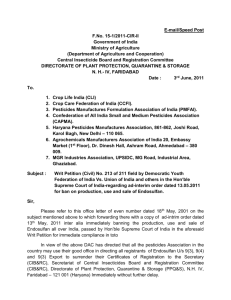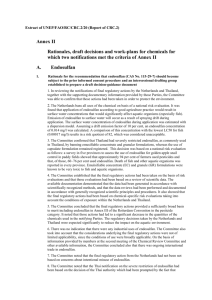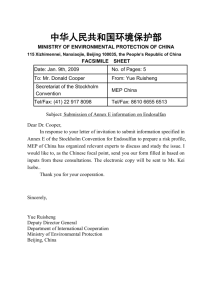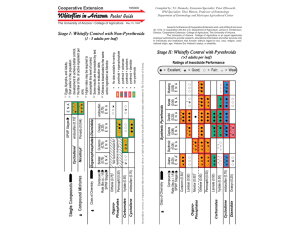Form for submission of information specified in Annex E
advertisement
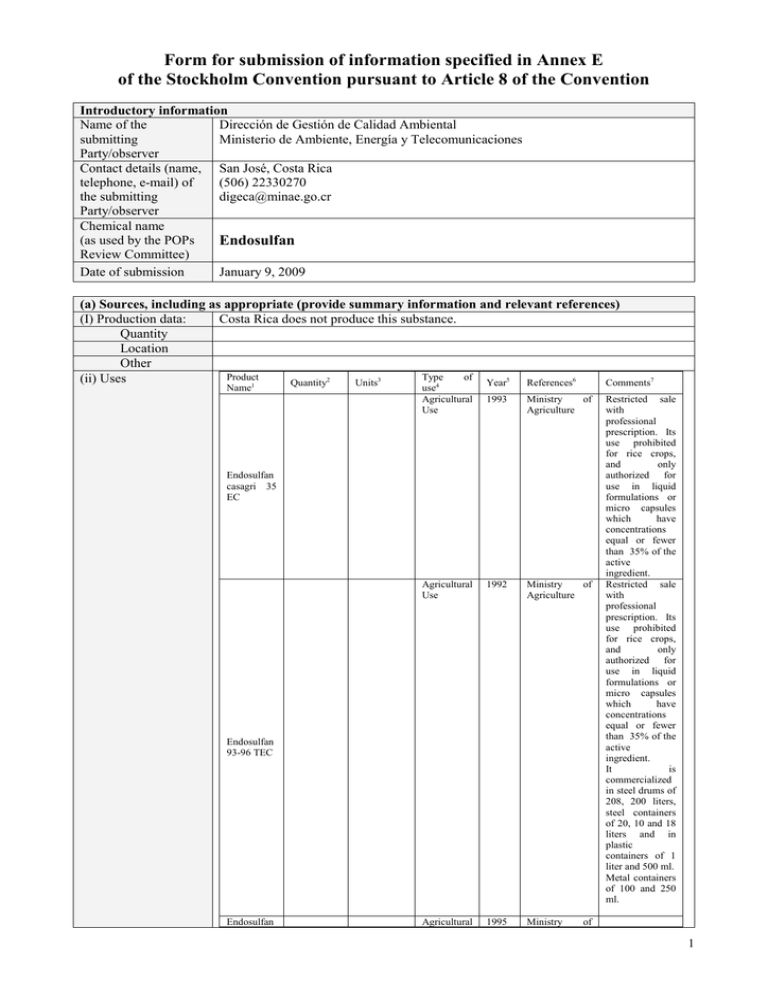
Form for submission of information specified in Annex E of the Stockholm Convention pursuant to Article 8 of the Convention Introductory information Name of the Dirección de Gestión de Calidad Ambiental submitting Ministerio de Ambiente, Energía y Telecomunicaciones Party/observer Contact details (name, San José, Costa Rica telephone, e-mail) of (506) 22330270 the submitting digeca@minae.go.cr Party/observer Chemical name (as used by the POPs Endosulfan Review Committee) Date of submission January 9, 2009 (a) Sources, including as appropriate (provide summary information and relevant references) (I) Production data: Costa Rica does not produce this substance. Quantity Location Other Product Type of (ii) Uses Quantity2 Units3 Year5 References6 Comments7 1 4 Name use Agricultural Use 1993 Ministry of Agriculture Agricultural Use 1992 Ministry of Agriculture Agricultural 1995 Ministry Endosulfan casagri 35 EC Endosulfan 93-96 TEC Endosulfan Restricted sale with professional prescription. Its use prohibited for rice crops, and only authorized for use in liquid formulations or micro capsules which have concentrations equal or fewer than 35% of the active ingredient. Restricted sale with professional prescription. Its use prohibited for rice crops, and only authorized for use in liquid formulations or micro capsules which have concentrations equal or fewer than 35% of the active ingredient. It is commercialized in steel drums of 208, 200 liters, steel containers of 20, 10 and 18 liters and in plastic containers of 1 liter and 500 ml. Metal containers of 100 and 250 ml. of 1 36 EC Use Agriculture Imports Imports 2006: In the year 2006 92.286 kilograms of Endosulfan active ingredient was imported, of these imports 59.632 kg, a.i. in technical grade (TC) and the rest in formulated product at 35 to 36%. Of the product imported as TC a total of 170.377 liters of Endosulfan at 35% were formulated, plus the 93.226 liters of Endosulfan imported at 35%. We can therefore conclude that for this year the amount of active ingredient that entered the country would formulate 263.603 liters of commercial at 35%. Imports 2007 In the year 2007 42.475 kilograms of Endosulfan active ingredient were imported, of these 20,820 kg, a.i. technical grade (TC) and the rest of formulated product at 35 and 36%. Of the product imported as TC a total of 59.486 liters of Endosulfan at 35%, and the rest of the 61.825 liters of Endosulfan imported were formulated at 35%. For this year the imports were sufficient to formulate 121.31 liters of commercial product at 35%. The TC product is imported from countries like Hungry (1.880 kg i.e.), India (2.820), Germany (6.724), China (9.400). Of the product that was formulated at 35%, the imports come from the following countries: Guatemala (Bayer – 5.291 kg i.e.) as Thiodan, Guatemala (Duwest- 596); Venezuela (1.750), USA- 4200, Israel – 6.772 as Thionex, Ecuador – 176, Belgium 1.120, India – 4.570, Hungary -1880, China – 9400. Imports Endosulfan 2000-2007. Costa Rica 100.000 92286,06 90.000 80.000 Kg a.i.70.000 62.428,1 63352,43 60.000 50.000 42.709,1 40.000 31.901,4 33.588,3 2000 2001 42.475,3 36.801,1 30.000 20.000 10.000 0 2002 2003 2004 2005 2006 2007 Years (iii) Releases: Discharges Findings in water: 2001-2002, Cartago, Central. Evaluation of runoff waters. Thirteen samples of water were taken with the following results: 12 positive for Endosulfan (92%). 470 uGu/l .Rodríguez – Brenes OM. 1998. Pesticide residues in the area of influence of the Tempisque Arenal Water Project: Final report. Centro de Investigación en Contaminación Ambiental. Universidad de Costa Rica. San José Costa Rica. 93p. 1999-2000. San José de la Montaña, Heredia. In superficial waters Endosulfan at (9,3 ug/l) and Endosulfan b (8,9 ug/l) was found. Elba de la Cruz PhD, Clemens Ruepert Mac, Catharina Weaseling PhD, Patricia Monger Mac, Fabio Chavarria Mac, Luisa Castillo PhD y Varian Bravo. 2004. LOS PLAGUICIDAS DE USO AGROPECUARIO EN COSTA RICA: IMPACTO EN LA SALUD Y EL AMBIENTE. Report of consultation of the Área de Servicio Agropecuario y Medio Ambiente de la Contraloría General de la República. Instituto Regional de Estudios en Sustancias Tóxicas. Universidad Nacional. 221 pp 2001-2002. San José, Heredia y Cartago Central. Evaluation of natural spring water for human consumption, 96 samples. Resulting in Endosulfan at (2,0 ug/l), Endosulfan b (<1,4) Readman JW, LL Wee Kwong, LD Mee, J Bartocci, G Nilve, JA Rodríguez-Solano y F González-Farias. 1992. Persistent organic phosphate pesticides in tropical marine environments. Marine Pollution Bulletin, 24(8) : 398-402. ; Endosulfan sulfate (<1, 4 ug/l). Von Duszeln J. 1988. Pesticide analysis in Costa Rica, with special emphasis in water and fish samples. Agencia de Cooperación Técnica Alemana (GTZ). Technical Report. Bremen, 2 Germany Report No GTZ PN 85.2039-7; these authors also report in superficial and residual waters in the Pacific the presences of metabolites Endosulfan a y b. 2001, Fraijanes, Alajuela. In samples of superficial waters the findings were: endosulfan at (0,1 ug/l) and endosulfan b (1,0 ug/l); in sediments endosulfan at (9 ug/l) and endosulfan b (46 ug/l); and in nursery soils endosulfan a (1 ug/l) and endosulfan b (2,6 ug/l). IRET-UNA. 2002. Results of the analysis of the samples taken in the vicinity of Escuela de Laguna de Fraijanes, Sabanilla de Alajuela. Internal Report 3p. FINDINGS IN AIR AND DUST: 2006, Cabo Blanco, Lepanto, Puntarenas. In the air in the vicinity of the location’s school, with a suction pump sampler, the following are the findings: Endosulfan at a concentration of 209,4 ug/l (Endosulfan a) and 8,5 ug/l (Endosulfan b). In the street dust that runs in front of a melon plantation the following results were obtained: 5 ug/l of Endosulfan and 4 ug/l of Endosulfan b. (Ruepert, Clemens. 2008. Personal communication). Losses Emissions Other (b) Hazard assessment for endpoints of concern, including consideration of toxicological interactions involving multiple chemicals (provide summary information and relevant references) Title of the study or report 1 Principal results contributions 2 23 cases of intoxications 2007 Report o References 3 Comments 4 Centro Nacional de Control de Intoxicaciones Dra. Ana Salas Herrera There is no specific cause for the intoxications, but since it is a pesticide that has intoxications due to the way it is applied (skin, inhalation) and ingestion (homicide). (c) Environmental fate (provide summary information and relevant references) Chemical/physical properties State: liquid Chemical Group: organic chloride Persistence During its application is there are air emissions, which can move the particles large distances. In soils it is moderately persistent (life average of 50 days), specially for the pH acid. The a-Endosulfan is less persistent than the βEndosulfan, with periods of degradation to a neutral pH that last 35 and 150 days, respectively. Both isomers are relatively resistant to the photolysis, but this is not the case with the degradation products (Endosulfan sulfate and diol Endosulfan. The available fraction in soils is degraded biologically within weeks, forming Endosulfan sulfate as the most important metabolite, which is relatively stable and persistent. 3 The fraction that is absorbed by the particles can persist for years and is has less possibility of leaching to the subterraneous waters. The mid-life in the water is 4 days, especially with solar exposure; but its degradation can be prolonged significantly under anaerobic conditions and acid pH. In the water the main metabolite formed is the diol Endosulfan. In this medium it is susceptible to experiment a slow hydrolysis. How are chemical/physical properties and persistence linked to environmental transport, transfer within and between environmental compartments, degradation and transformation to other chemicals? The organic chlorides The organic chlorides are insoluble in water; they are soluble in compounds that have a low polarity, very stable. This compound has more of an affinity for the lipids than other organic chloride pesticides, this is the reason for its bioaccumulation and its biomagnifications is less probable. In many organisms (shell fish, algae, fish and mammals) exposed to subletal concentrations of this pesticide, it accumulates until it reaches a stationary phase; although, it does not persist in its tissue once the source of exposure has disappeared, because it is metabolized very quickly in the liver and the kidneys in order to be eliminated from the body. In the plants it is transformed to sulfate. In the majority of fruits and vegetables, 50% of its residues disappear from 3 to 7 days. When there is a combustion of organic chlorides in non controlled conditions dioxins and furans are produced, which are highly toxic compounds, they are active physiologically in extremely small doses; they are persistent, in other words they do not degrade easily and can persist for year in the environment; they are bioaccumulative in the fatty tissues of the organisms and they biomagnify, this means that they increase their concentration progressively through the food chains. Due to their persistence they can travel large distances by atmospheric currents, marine and fresh waters, and through migration a large distance from the organism that have bioaccumulated them. Bio-concentration or bioaccumulation factor, based on measured values (unless monitoring data are judged to meet this need) Bioaccumulation: from medium to high. The birds are very sensitive to intoxication with this substance, just as several species of fish and shell fish. It is moderately toxic for bees. (d) Monitoring data (provide summary information and relevant references) In the analysis of vegetable products done between 2001 and 2003 it was found that in 6% of the samples ( in levels <0,02-3 mg/kg) and in 0.5% of the same in concentrations above the permitted levels. The vegetables with residues were: celery, chayote, green peppers, strawberries, lettuce, tomato (MAG, 2003). Also it has been reported in the tomato samples done in the Pococí county in 1977-1988 (Valverde, et al., 2001). Contamination of bodies of water and sediments: residues of Endosulfan ( some of its three metabolites alfa, beta or sulfate) have been reported in bodies of water and sediments in the central region of the country. They are associated with the ornamental plant production and probably vegetables and in samples from the Pacific they are associated with the rice crop in concentrations that go from 0,04 a 470 µg/L and 9µg/kg ph respectively for the central region and 0,02 µg/L in the Pacific. Endosulfan was found in 92% of the samples under study (during one year) by the MAG in crop runoff water samples. (e) Exposure in local areas (provide summary information and relevant references) General As a result of long-range environmental transport 4 The highest levels of Endosulfan in the air were found in the Central Valley, the zone with the largest population in Costa Rica and in the Palo Verde National Park, closet o rice and melon plantations. The highest concentration of Endosulfan in soils was found in 5 sites with elevations above the 2500 msnm (Prusia, Irazú, Tapantí, Barva y Poás),particularly high resulting from the concentrations in soils at higher altitudes. (Barva >3000pg/g and Poás >1600 pg/g). It is supposed that the origin of the Endosulfan found in the National Parks and in the higher zones where there is no agricultural activity, comes from the banana, pineapple and other crops of the Caribbean zone, that due to transport by evaporation there is movement by water and later condensation and deposition in the protected soils (Daly, L. et al. 2007. Accumulation of current-use Pesticides in Neotropical Mountain Forests. In: Environ. Sci. Technol. V 41 Nº 4. 1118-1123). From October 2005 to October 2006 air samples were taken in San Antonio de Belen, Heredia. Relatively high concentrations of Endosulfan were founds (between 49 and 564 pictograms per m3 of air), with an average of 261. Endosulfan b, the less abundant isomer in the technical mixture and the metabolite the Endosulfan sulfate were observed in the samples with concentrations averaging 65 and 6 pg/m3, respectively. It is believed that the source of Endosulfan is from the coffee plantations close to these urban areas. (Todd, G. et al. 2008. Field Testing Passive Air Samplers for Current Use Pesticides in a Tropical Environment. In: Environ, Sci. Technol. 42, 6625-6630. Information regarding bioavailability (f) National and international risk evaluations, assessments or profiles and labeling information and hazard classifications, as available (provide summary information and relevant references) (g) Status of the chemical under international conventions ___________________________ 5
